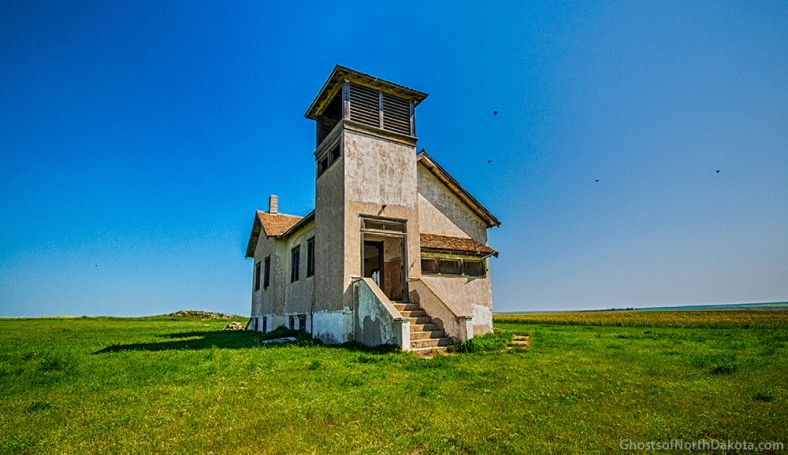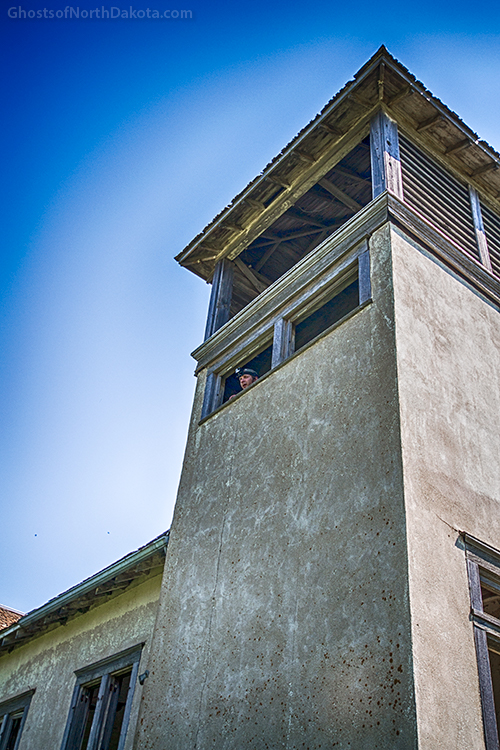Officially, this church is now known as Susan Webb Hall Memorial Congregational Church. It once served Elbowoods, North Dakota, a town now-submerged under Lake Sakakawea, as part of the Fort Berthold Indian Mission which dates back to the 1870s.
Update: This church was reportedly burned by an arsonist in 2019.
The church was organized in 1899 and this building was erected in Elbowoods in 1926. It was relocated in 1953 to a spot on high ground, nearly eight miles north-northeast of Elbowoods, to escape the rising waters of Lake Sakakawea behind the newly constructed Garrison Dam. It is just off ND 1804, about fourteen miles west of Roseglen, and it is one of a number of structures which were relocated from Elbowoods.
The state historical society has a photo of five young girls standing on the steps of this church in the twenties to forties era here.
This church was featured in our book, Churches of the High Plains.
Charles Hall, an Englishman with a thirst for spreading the gospel, set out for so-called Indian country in 1874. He married his first wife, Emma Calhoun, who died a few years later, then remarried Susan Webb, the namesake of this church. The late Reverend Harold Case wrote a book called “100 years at Fort Berthold” in 1977 which tells the story of Elbowoods. Charles Hall died in 1940.
Looking out on the cemetery from the bell tower.
It’s an understandably sensitive subject when you’re talking about people’s remains, but the appearance of this cemetery suggests some of the deceased who died prior to 1953 were originally interred elsewhere, then relocated to this place, presumably to escape the coming flood. I haven’t spent enough time at the library to know the full-story, so please leave a comment below if you know more.
This monument dedicated to the Hall family stands in the center of the cemetery.
It reads: Emma Calhoun Hall. Born 1850 — Died 1881. She was the first to give her life as a missionary for Christ among the Mandan, Gros Ventre and Arichara Indians.
We visited this place to pay our respects to those who came before us, and to shine a spotlight on a place that had a prominent part in the settlement of our state, but is forgotten or altogether unknown by most. Unfortunately, our visit was seen by a few as an unwelcome intrusion by outsiders, and we’re told a fence has been erected around this church in the time since, and visitors are not welcome.
The marker simply reads “Bell Porcupine”
This marker was so weathered, I could only make out the word “died,” and the “Porcupine” name on the headstone.
This marker reads: Austin White Duck. Born Mar. 1st, 1903. Died December 24th, 1909.
Photos by Troy Larson and Terry Hinnenkamp, © Sonic Tremor Media

















Charles Hall, whose monument you show, a Congregational missionary, active in the YMCA, moved out here to work with Native American youth — thus we have Charles Hall Youth Services. He was largely responsible for getting a bridge to be built in 1922 across the Missouri River at Elbowoods which was called the Four Bears Bridge and was later moved to be near that new town the Army Corps of Engineers laid out when it flooded the valley. That new town never changed its name and is still New Town.
LikeLike
Thank you for posting this gallery. I hope someone has a record of these deceased so their memories of lives on this earth are not forgotten. Again, thank you, from a former Mountrail County resident..
LikeLike
So lovely to see the photography. Because I grew up in McLean County, these pictures give me a real sense of place. The photos of the cemetery remind me of the old South Saint Olaf Church site and cemetery south of our family farm. As always, thanks.
LikeLike
Great photos. Really captures the vastness and lonliness of the plains. Imagine being out there in 1880, homesteading perhaps, the middle of winter with the wind howling across the pairie…
LikeLike
I am a Congregational minister in Iowa so it is wonderful to see some of the church buildings and hear of the history concerning the Elbowoods Church. Thanks for the pictures and mention of the book telling the history of the area. Your objective is noble!
LikeLike
I for one, am not the least bit offended about this. My mother told me about this church and the Christmas’s that were celebrated in it. The Sundays they went to town to go to church. Yes it was upsetting and the effects that scarred my mother from the flood was devastating to her. She would always say, I can’t go home. But history is important and thank you for documenting this.
LikeLike
I read a book years ago, Cadillac Desert, it’s about the building of the dams in the US. It is a great read! For anyone affected, you will remember it forever!
LikeLike
I think you guys are wonderful and love what you do..remembering the past for the future is the reason to do what you do
LikeLike
Thank you for tours of forgotten & unknown history in North Dakota. I love the history of both North Dakota & Montana.
LikeLike
Thank you for your wonderful work. Even tho I’m not a North Dakotan (I came from eastern Mont, west of Sidney)
I still appreciate your great work. I hope someone is doing that for Montana.
Now I have a question: Sometime ago (2-3 years) while listening to ND Public Radio, we heard of a book someone wrote about about people being moved. One of the stories in the book was about a lady who went to town after being cooped up on a ranch all winter. She stayed a bit longer than she intended, as she met some friends she hadn’t seen all winter. When she arrived home, in the dark, fairly late, she could not find her home, barns or family. The story goes that while she was in town all day, the government (or some body) came and moved all of their buildings and such to place where they would be safe from the rising Dam waters.
Does anyone out there know about this book? The title, author, whatever. I would like to get a copy of that book if possible.
Thanks for any help in advance
Jon K
LikeLike